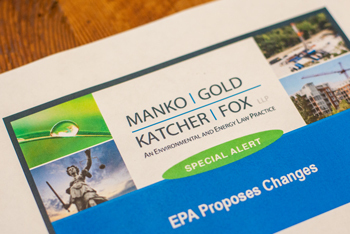Key Contacts
EPA Announces Preliminary PFOA and PFOS Regulatory Determinations for Drinking Water
On March 10, 2020, the United States Environmental Protection Agency (EPA) moved a step closer to establishing a national drinking water standard for Perfluorooctanoic acid (PFOA) and Perfluorooctanesulfonic acid (PFOS) by publishing its Announcement of Preliminary Regulatory Determinations for Contaminants on the Fourth Drinking Water Contaminant Candidate List (CCL 4). Of the eight contaminants reviewed in the Announcement, according to EPA only PFOA and PFOS met the relevant criteria for regulation under the Safe Drinking Water Act (SDWA). While the decision to take this next step with respect to PFOA and PFOS was not necessarily a surprise, in the Announcement EPA requested public comment and additional data that could not only affect final drinking water standards for PFOA and PFOS, but also possible future standards for a broader class of PFAS.
As detailed in the Announcement, EPA’s preliminary determination to establish drinking water standards for PFOA and PFOS promulgating a National Primary Drinking Water Regulation (NPDWR) resulted from EPA’s review of health, occurrence, and other information against the three relevant SDWA statutory criteria. Specifically, EPA evaluated whether:
- PFOA and PFOS may have an adverse effect on human health;
- PFOA and PFOS occur in Public Water Systems (PWS) with a frequency and at levels of public concern; and
- Regulation of PFOA and PFOS presents a meaningful opportunity for health risk reduction for persons served by PWS. EPA answered “yes” for all three criteria and therefore decided to move forward with the preliminary determination to regulate.
If EPA ultimately makes a final determination to regulate PFOA and PFOS, EPA would then be required to publish a proposed Maximum Contaminant Level Goal (MCLG) and NPDWR for PFOA and PFOS within 24-months. After proposed MCLGs and NPDWRs are published, EPA would then need to publish a final MCLG and promulgate a final NPDWR within 18-months.
While a final decision to regulate PFOA and PFOS seems like a foregone conclusion, the upcoming comment period provides opportunities for stakeholders to provide comments and additional data that could influence the ultimate MCLG and the scope of the NPDWR. For example, in support of the first criteria EPA stated that the agency is undergoing a systematic review of peer-reviewed scientific literature published since 2013 with the goal of identifying new studies that may be relevant to human health. Therefore, EPA is specifically seeking comment on any additional peer-reviewed science and supporting studies that it should consider as part of this preliminary determination to regulate PFOA and PFOS. Regarding the second criteria, EPA is requesting additional occurrence data that it can use to supplement the analysis already performed (which included updated occurrence data from New Hampshire, Colorado, Michigan and New Jersey) to inform its determination that PFOA and PFOS occur in PWS at sufficient frequency and at levels of public concern. And with respect to the third criteria, EPA is seeking comment on the opportunity for health risk reductions to infants, children, and adults, including pregnant and nursing women due to the potential adverse human health impacts of the contaminants at low concentrations, their persistence in the environment, persistence in the human body, the availability of methods to measure, and treatment technologies to remove the contaminants from PWS.
Finally, as stated in EPA’s PFAS Action Plan (2019), the Agency is evaluating PFAS other than PFOA and PFOS, which would inform the development of a national drinking water regulation for a broader class of PFAS in the future. To that end, the agency is seeking public comment on potential regulatory constructs and monitoring requirements that the Agency may consider for a larger swath of PFAS chemicals. Namely, the EPA is considering three potential regulatory approach options including:
- Evaluation of additional PFAS on an individual basis,
- Evaluation of additional PFAS by different grouping approaches, and
- Evaluation of PFAS based on drinking water treatment techniques.
On a separate, but related item, EPA also noted in the Announcement that to further understand occurrence of PFAS in drinking water, EPA is set to propose a nationwide drinking water monitoring program under the next Unregulated Contaminant Monitoring Rule cycle 5 (UCMR 5), which will utilize newer test methods to capture more PFAS compounds at lower concentrations than previously measured.
Comments on the preliminary regulatory determinations are due June 10, 2020. The complete Federal Register Notice can be found here. If you have questions about EPA’s Announcement or are interested in submitting public comments, please contact Todd Kantorczyk (484-430-2359), Austin Manning (484-430-2334), or MGKF technical consultant Michael Nines (484-430-2350).
Updated May 4 to reflect change in comment deadline date.

